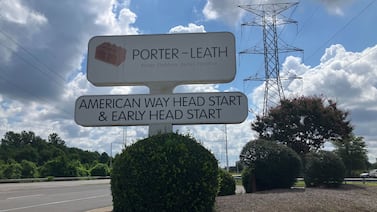Sign up for Chalkbeat Colorado’s free daily newsletter to get the latest reporting from us, plus curated news from other Colorado outlets, delivered to your inbox.
Colorado voters face a complex decision on their November ballots that will affect property tax bills, income tax refunds, and school funding for at least the next decade.
Proposition HH asks: Shall the state reduce property taxes for homes and businesses, including expanding property tax relief for seniors, and backfill counties, water districts, fire districts, ambulance and hospital districts, and other local governments and fund school districts by using a portion of the state surplus up to the Proposition HH cap as defined in this measure?
If that sounds complicated, it is.
Gov. Jared Polis and Democratic lawmakers placed Proposition HH on the ballot this spring as homeowners received new property assessments that increased their values an average of 40%. Lawmakers worried that dramatic property tax increases would hurt businesses and lower income homeowners and give momentum to conservative efforts to cut taxes further.
Proposition HH would reduce how much property value is taxable, blunting the impact of higher assessments. It also would limit how much additional revenue most local governments could collect year over year. School districts would be exempt from that second provision.
This means property owners would pay less under Proposition HH than they would otherwise — but also that park and library districts, fire departments, and school districts would collect less tax revenue than under current law.
At the same time, state government is bringing in more money than ever from income and sales taxes due to a strong economy. The Taxpayer’s Bill of Rights limits how much spending can increase to the rate of population growth plus inflation. Any money collected over that cap — estimated to be $1.9 billion next budget year alone — must be returned to taxpayers as refunds.
Proposition HH would raise the spending limit, allowing the state government to keep more money from existing taxes and reducing future TABOR refunds. The extra money would be used to backfill some of the lost local revenue, shore up the state education fund, and provide rental assistance.
Proponents say Proposition HH balances property tax relief and the need to fund critical government services. It would allow Colorado to protect education funding against future recessions and keep up with inflation. If Proposition HH passes, Colorado could meet its constitutional school funding obligations and then some — something the state hasn’t done for more than a decade.
Opponents of Proposition HH say it’s essentially a tax increase to fund schools — something voters have repeatedly rejected at the state level — disguised as property tax relief. There are no guardrails to ensure the extra money would improve teacher pay or student achievement, they say.
Here’s a closer look at how Prop HH would affect school funding.
How are property taxes and school funding related?
Colorado funds its school with a mix of local property tax revenue and state funding that comes from income taxes, sales taxes, oil and gas revenue, and other sources. Colorado uses a formula to determine how much total funding each school district should get per student. Whatever local taxes don’t cover, state funding makes up the rest.
By limiting the taxable value of property, Proposition HH slows the growth in local revenue and increases the state obligation toward K-12 schools.
Out of a roughly $9 billion K-12 budget, legislative analysts estimate the state would owe school districts an extra $130 million this budget year under Proposition HH, an extra $310 million next year, and another $360 million in the 2025-26 school year.
How would Colorado backfill school district budgets?
Proposition HH would raise the cap on state government spending by 1% a year, allowing the state to keep and spend more money from existing taxes. Less money would be available for TABOR refunds going forward.
That retained revenue would backfill local government budgets. Lawmakers have pledged to hold school districts harmless, meaning they’ll get the same amount of money under Proposition HH as without it. Other local taxing districts, like fire and library districts, would get some backfill but not as much.
State analysts estimate Proposition HH would generate $125 million for schools in the 2024-25 budget year and up to $2.16 billion in the 2031-32 budget year. But the farther out the economic forecast goes, the more uncertainty there is.
Over time, the need for backfill would go down as property values continued to rise, and the state would have more money in the education fund. Depending on economic conditions, this money could allow Colorado to increase school funding or avoid cuts during a recession.
Would Proposition HH get rid of TABOR refunds?
Under current law, Colorado is set to return billions of dollars to taxpayers over the next several years, with higher earners getting larger refunds. Next year, budget analysts estimate taxpayers will receive between $586 and $1,834 depending on how much they earn.
Under Proposition HH, all taxpayers would receive a flat refund of $833 next year, but after that, the state would keep more of the excess money and refunds would be smaller.
Whether money is available for TABOR refunds would depend on economic conditions and how much revenue the state collects. That’s true today as well — some years, taxpayers don’t see any money back.
But under Proposition HH, as the state spending limits got higher, it would become more likely that taxpayers wouldn’t get refunds in the future.
Do Colorado schools need more funding?
Colorado’s school funding is below the national average, despite recent increases. Starting salaries in small rural districts are among the lowest in the nation, and even districts that have raised teacher pay haven’t kept up with the rising housing costs.
Amendment 23, approved by voters in 2000, requires that education funding increase each year at the rate of population growth plus inflation. But that hasn’t happened since 2008. When tax revenues plummeted during the Great Recession, lawmakers started diverting education money to other priorities. This withholding, known as the negative factor or the budget stabilization factor, has added up to more than $10 billion that never went to schools.
Even without Prop HH, Colorado is on track to eliminate the withholding next year. But with spending obligations linked to inflation, and potentially billions needing to be returned to taxpayers under current law, it’s unclear whether Colorado could sustain constitutionally required funding levels into the future. K-12 spending takes up more than a third of Colorado’s general fund, squeezing out other programs, including higher education.
Conservatives say the state could fund schools adequately if lawmakers just prioritized education. They question whether school districts are spending too much on administrative costs instead of paying teachers more.
Progressive education advocates say even meeting Amendment 23 requirements wouldn’t be enough. Adjusting for inflation, that would bring Colorado to 1989 funding levels, while schools today are expected to do a lot more, from providing advanced career and technical education to supporting students’ mental health.
Is Prop HH a property tax measure or a school funding measure?
Supporters have pitched Proposition HH as property tax relief. But back in May, then-Senate Majority Leader Dominick Moreno called it “a key piece of the solution” to decades of underfunding Colorado schools.
Education groups, including teachers unions and Education Reform Now Advocacy, are major backers of the property tax measure. The Colorado Association of School Boards has also come out in support.
“Any measure that tries to reduce property tax revenue has to account for what happens to school funding,” said Scott Wasserman, president of the left-leaning Bell Policy Center, which supports the measure. “Opponents try to act like a bait and switch. It’s not a bait and switch.”
Wasserman said doing nothing risks provoking a taxpayer backlash that could lead to even stricter limits on the growth of government that would hurt schools. Already, conservative activist Michael Fields has placed a 4% property tax cap on the ballot for 2024.
Along with Republican lawmakers and conservative activists, opponents include the Colorado Municipal League, the Colorado State Fire Chiefs, and the conservative education group Ready Colorado.
An analysis from the Common Sense Institute estimates an extra $9.6 billion would go to education over the next decade under Proposition HH. The analysis notes that school districts don’t have to use the money to raise teacher pay, and there’s no guarantee student outcomes will improve.
“I’ve been surprised to see how much money could be allocated to education without any guardrails,” said Kelly Caufield, the institute’s executive director.
The Common Sense Institute estimates 95% of additional state revenue would go to schools under Proposition HH. But lawmakers aren’t required to increase school funding above Amendment 23 requirements. Caufield said the money could end up freeing up general fund dollars to grow other programs.
Tracie Rainey of the Colorado School Finance Project doesn’t see Proposition HH as a school funding measure, just a way to mitigate the impact of property tax relief.
“If the economy stays strong and if we don’t have an economic downturn and if inflation isn’t running wild, then possibly, down the road, there could be additional dollars,” she said. “There’s a lot of ifs in there that make it hard to know.”
Bureau Chief Erica Meltzer covers education policy and politics and oversees Chalkbeat Colorado’s education coverage. Contact Erica at emeltzer@chalkbeat.org.







